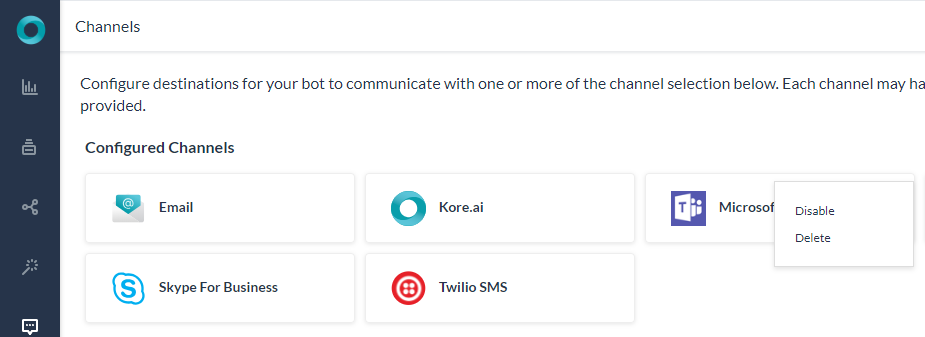To add Microsoft Teams channel to your bot, you must create a bot in the Microsoft Bot Framework account to configure the connection between Microsoft Teams and Kore.ai. To add the Microsoft Teams channel to your bot, follow the below steps:
- Register the Bot – You must create a bot in the Microsoft Bot Framework by adding all the bot details and creating the App ID and Password. To register the bot, you must have created and registered for a free account in the Microsoft Bot Framework developer portal.
- Enable Channel – After registering the bot, enable the channel.
- Publish Channel – After the channel is enabled and all configurations are verified, you can optionally publish the bot to make it available for developers.
Register the Bot with Microsoft Teams channel
To set up Microsoft Teams as a channel, you must register a Bot Channel service in Azure and enable a webhook for the platform to receive messages.
You need an active subscription to Azure services with admin access to subscribe for a new Azure service.
Register a Bot Channel
- Log in to the Microsoft Bot Framework portal.
- On the portal menu, click + Create a resource.
- Search and select Bot Channels Registration from the search window.
- Click Create and proceed to the next screen to enter the details.
- Enter all the required details to register the bot channel.
- From the Bot Builder platform, copy the Webhook URL from the Configurations tab of the Channel page for Microsoft Teams and provide it in the Messaging Endpoint field.
App Association
The Bot Channel Regsitration must be associated with a Microsoft App ID and Password. You can choose to go with the default option of Auto-create App Id and password if you want your bot to be available for multiple tenants or users outside of your Azure domain. You can also choose to create your own App ID and password and define who is eligible to access your bot. Follow the instructions available here for more details.
- Click Create to complete the registration.
- After successful creation, you are redirected to the Dashboard of your Azure account.
Configure App Id and Password
From your Azure Dashboard, select the resource that you have created in the previous steps. You are redirected to the details page of the new resource that you have created.
- On the left pane, click Settings > Manage next to the Microsoft App ID field.
- Under the Certificates and secrets section, click + New client secret. Provide the necessary details, and click Add to create a new client secret.
- Copy the Value of the new client secret and provide it in the App Password field present in the Configurations tab of this window.
- Close the Certificates and secrets section to return the Settings section.
- Make a note of the App Id present on the Settings page and enter it in the Configuration tab of this window.
- Click Save to save your changes.
Enable Microsoft Teams Channel
- On the menu, go to the Channels and select the MS Teams channel.
- You are redirected to the channel information page. Review the information and click Save to complete the channel setup.
To enable Microsoft Teams channel, follow the below steps:
- In the Bots section of the Bot Builder, click the bot you want to add the Microsoft Teams channel to.
- On the Channels tab, click the Microsoft Teams icon. The Microsoft Teams channel page is displayed.
- Go to the Configuration tab of the Microsoft Teams channel page to update or review the app configurations and enable the channel.
Edit Microsoft Teams Channel
To edit the Microsoft teams channel, follow the below steps:
- Hover over the channel and click to modify. Make necessary updates to your channel configurations and save them.
- You can also disable or delete the channel information by clicking the Settings icon.

Select one of the following commands to modify the channel:
- Disable/Enable – Click Disable to temporarily disable the use of the Microsoft Teams channel for your bot. To enable the use of the Microsoft Teams channel, Click Enable.
- Delete – Click Delete. On the Delete Confirmation dialog box, click OK to permanently delete the bot channel configuration.
